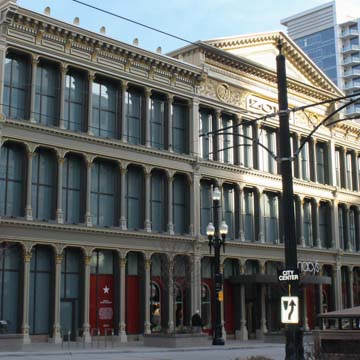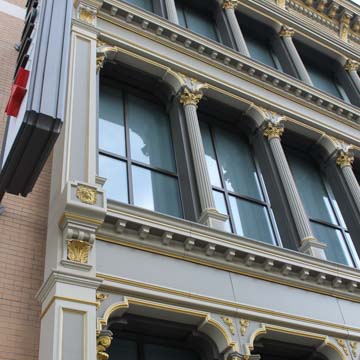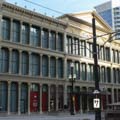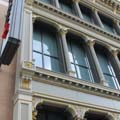You are here
Macy’s
The Zion Cooperative Mercantile Institution (ZCMI), one of the first department stores in the United States, was established in 1868. Its flagship store in downtown Salt Lake City was completed in 1876, and consolidated different entities of ZCMI under one roof. The department store typology, first employed at Le Bon Marche in Paris in 1869, was part of the modernization of cities and their reorganization into nascent centers of bourgeois consumer culture. In the mid-nineteenth century, Salt Lake City was a strategic commercial hub of the American West. It served as a supply station for mining camps, immigrant trains, and soldiers stationed at Fort Douglas, and was an obvious site for the elaboration of commerce in the western United States. But it never compared in scale with Chicago, from where commodities were imported, and indeed, ZCMI was organized by the Church of Jesus Christ of Latter-day Saints as a means to protect Mormon traders and retailers from price gouging from non-Mormon suppliers.
ZCMI’s flagship store was a three-story, L-shaped structure on Main Street between South Temple and First South. It was built in three phases between 1876 and 1901. The impressive cast-iron facade with its large plate-glass windows revealed the display and consumption found within the store. Delicate Corinthian columns parading across the facade on each of the three levels form a lacelike pattern over the plate-glass windows, their prefabricated pieces masking the relative heaviness of the brick and timber structure behind. Local materials (Utah pine and clay bricks from nearby Bountiful) were masked with the anonymity of the industrial materials of iron and glass.
The 1901 expansion maintained the rhythm of the earlier facade and resulted in today’s three-part composition. The new columns were of stamped sheet metal rather than cast iron. The 140-foot-long facade is topped by a central pediment and heavy dentiled cornice. The whole ensemble spoke of the steady increase of middle-class purchasing power at the turn of the century. ZCMI was innovative in several ways, becoming the country’s first department store to establish its own clothing line and Salt Lake City’s first company to use delivery wagons and, later, have a fleet of automobiles. This was one of the first stores in the West to employ women as sales clerks. The building was notable for its early use of electric lighting, and in 1946 became the first store in the American West to install escalators. In 1954, ZCMI opened the area’s first parking terrace, with 514 stalls on six levels.
By the end of the nineteenth century, ZCMI had begun separating itself from the LDS Church, allowing non-Mormons to buy stock. The company continued to expand and open other locations throughout the Intermountain West, celebrating its 125th anniversary in 1993. But the downtown Salt Lake City location suffered in the late 1990s, as did much of the central business district, due to competition from big box stores, construction of a new light-rail system, and the renovation of I-15. In 1999, ZCMI was purchased by the St. Louis–based May’s Department Store Company and operated under the Meier and Frank name until it became Macy’s in 2005. The former ZCMI downtown store was demolished in 2011 for the construction of the City Creek Center shopping mall. The facade, however, was removed, restored, and reinstalled on the west facade of Macy’s department store, just north of the original ZCMI location. The restored facade features gold paint accents and retains the ZCMI name below the pediment, with the store’s dates of operation—1868 to 1999—on either side.
References
Writing Credits
If SAH Archipedia has been useful to you, please consider supporting it.
SAH Archipedia tells the story of the United States through its buildings, landscapes, and cities. This freely available resource empowers the public with authoritative knowledge that deepens their understanding and appreciation of the built environment. But the Society of Architectural Historians, which created SAH Archipedia with University of Virginia Press, needs your support to maintain the high-caliber research, writing, photography, cartography, editing, design, and programming that make SAH Archipedia a trusted online resource available to all who value the history of place, heritage tourism, and learning.




